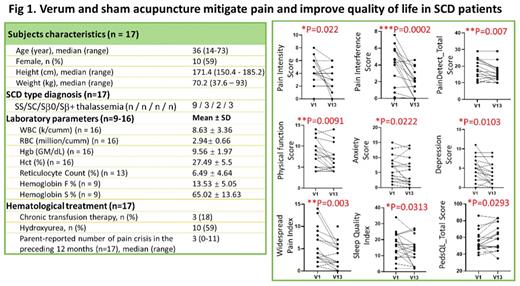Abstract
Background: Pain is a common and significant complication of sickle cell disease (SCD), and can be acute, chronic or a mixture of both. Vaso-occlusive pain crises (VOC) associated with SCD are severe acute pain episodes that are recurrent, unpredictable, frequently require hospitalization and rely on opioids as the main therapeutic option, leading to a lowered quality of life (QoL) (Osunkwo, I., et al., Am J Hematol, 2021). Emerging studies suggest that "mind-body" interventions, such as acupuncture, may be effective at reducing pain in SCD (Williams, H et al. J Pain Symptom Manage, 2016). Several studies showed that acupuncture was effective in alleviating pain in both adult and pediatric patients with SCD (Lu, K., et al. Clin J Pain, 2014; Tsai, S.L., Medical Acupuncture, 2015). Importantly, these non-pharmacological strategies have limited side-effects and may reduce the amount of opioid use in patients with SCD. Yet, the small sample size and lack of placebo control in these studies make it difficult to validate the efficacy of acupuncture in SCD. Our ongoing randomized sham-controlled trial (ClinicalTrials.gov Identifier: NCT05045820) is comprehensively assessing the effects of acupuncture on symptoms and mechanisms associated with chronic pain, VOC and QoL in patients with SCD.
Methods: A total of 41 patients with SCD have been enrolled to date, with a total anticipated enrollment of 75. A blinded interim analysis of 17 patients is reported here. Sickle patients aged 14-73 were randomized to either verum or sham acupuncture treatments. Demographic information of these participants is shown in Figure 1 (left panel). Each participant received 10 acupuncture treatments for 5 weeks. Pain intensity and physical function were assessed with PROMISE-29 whereas pain interference was assessed by the Brief Pain Inventory. Neuropathic pain symptoms were assessed with the PainDetect. The spatial distribution of pain across the body was assessed by the Widespread Pain Index. Anxiety and depression were assessed by Hospital Anxiety and Depression Scale. Quality of sleep and chronic fatigue were measured using the Pittsburgh Sleep Quality Index and Multidimensional Fatigue Inventory respectively. The sickle pain related QoL was assessed by PedsQL. A paired two-sample t-test (two tailed) was used to compare pre-treatment outcomes (verum and sham combined) at baseline (V1) to those collected post-treatment (V13). Other outcomes including MRI, fNIRS/EEG, quantitative sensory testing, as well as circulating biomarkers, were also collected before and after treatment. These results will be reported elsewhere.
Results: Combined verum and sham acupuncture treatment produced significant improvement for many patient-reported outcomes as seen in Figure 1 (right panel). Compared to baseline, pain intensity (p=0.022), pain interference (p=0.0002), physical function (p=0.0091) and neuropathic pain symptoms (p=0.007) were reduced following treatments. Anxiety (p=0.0222), depression (p =0.0103), sleep quality (p=0.0313), chronic fatigue (p=0.0876), and QoL (p=0.0293) also improved following acupuncture treatments. In addition, the number of body sites reported as painful (Widespread Pain Index) was also reduced relative to baseline (p=0.003).
Conclusion: To our knowledge, this is the first randomized controlled clinical trial investigating acupuncture for pain management in patients with SCD. These preliminary data suggest that acupuncture is effective at reducing multiple dimensions of pain and comorbidities in patients with SCD. However, because this trial is still under active recruitment, and these data were analyzed in a blinded manner without separating the verum and sham acupuncture treatments, these findings must be viewed with caution until completion of the study, which is expected within 12-18 months.
Disclosures
Jacob:Global Blood Therapeutics: Membership on an entity's Board of Directors or advisory committees.
Author notes
Asterisk with author names denotes non-ASH members.


This feature is available to Subscribers Only
Sign In or Create an Account Close Modal